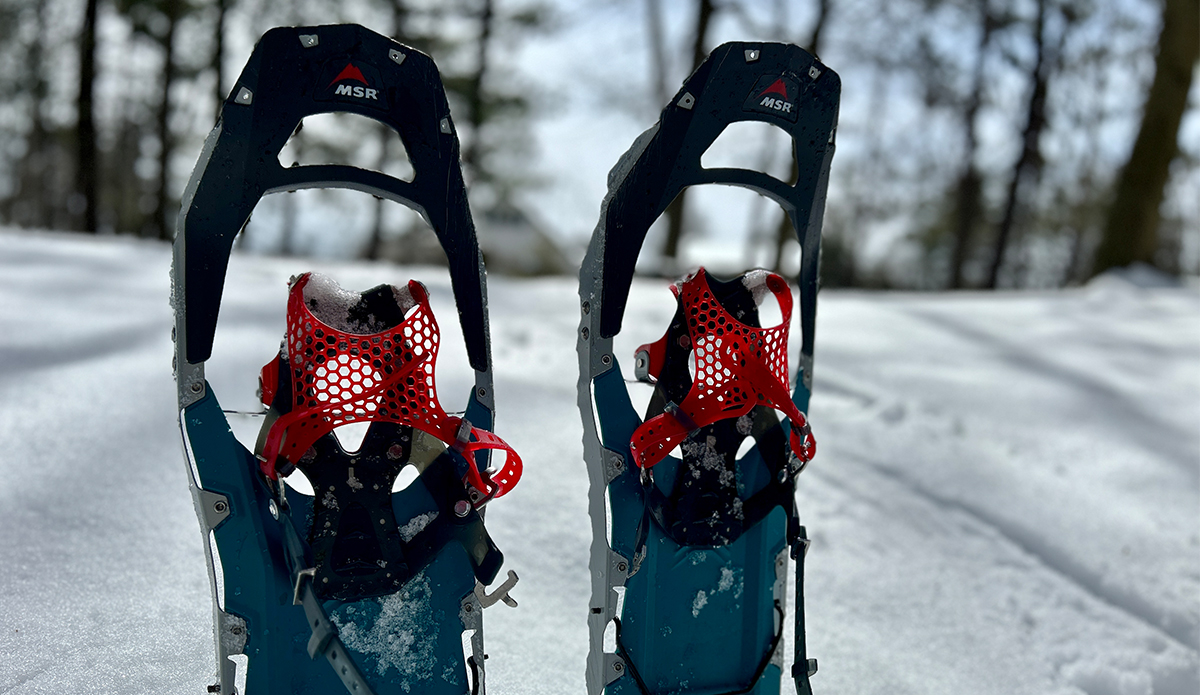
The MSR Revo Ascent Snowshoes are fantastic all-around winter tools. Photo: Rebecca Sperry/The Inertia
Finding the perfect snowshoes can be a frustrating (and expensive) process. With a variety of styles available, it can be difficult to know which snowshoes are suitable for the terrain you’ll be encountering. If you venture out with the incorrect pair, a beautiful experience can turn downright dangerous. My Best Snowshoes roundup looked at a smattering of the most popular models, as well as provided a comprehensive buyer’s guide to help you find the right snowshoes for the task. Now, I’m going to take an in-depth look at the Best Overall Snowshoe winner from that guide — the MSR Revo Ascent ($319.95).
Out of all of the pairs of snowshoes I’ve tested in my years hiking through New Hampshire’s White Mountains, The Revo Ascents are my favorite. With over nine winter seasons under my belt, I’ve seen just about all winter can throw at you. When setting out to test the Revo Ascents, I knew that it was imperative that I try them out on all sorts of trail conditions. From sticky spring snow to crusty, hard, sleet-coated powder, these snowshoes held up to everything the Whites threw at them. And that includes rocks, ice, and steep trail breaking!
| Pros | Cons |
| Durable frame and binding | Slightly wider frame than I’d like |
| 360 traction for easier pivoting and turning on trail | Composite frame feels less rugged than a metal frame |
| Easy-to-use heel lifts | bindings are a bit cumbersome to hitch |
| Slightly less expensive than comparable MSR Lightning Ascents |
First Impressions of the MSR Revo Ascent
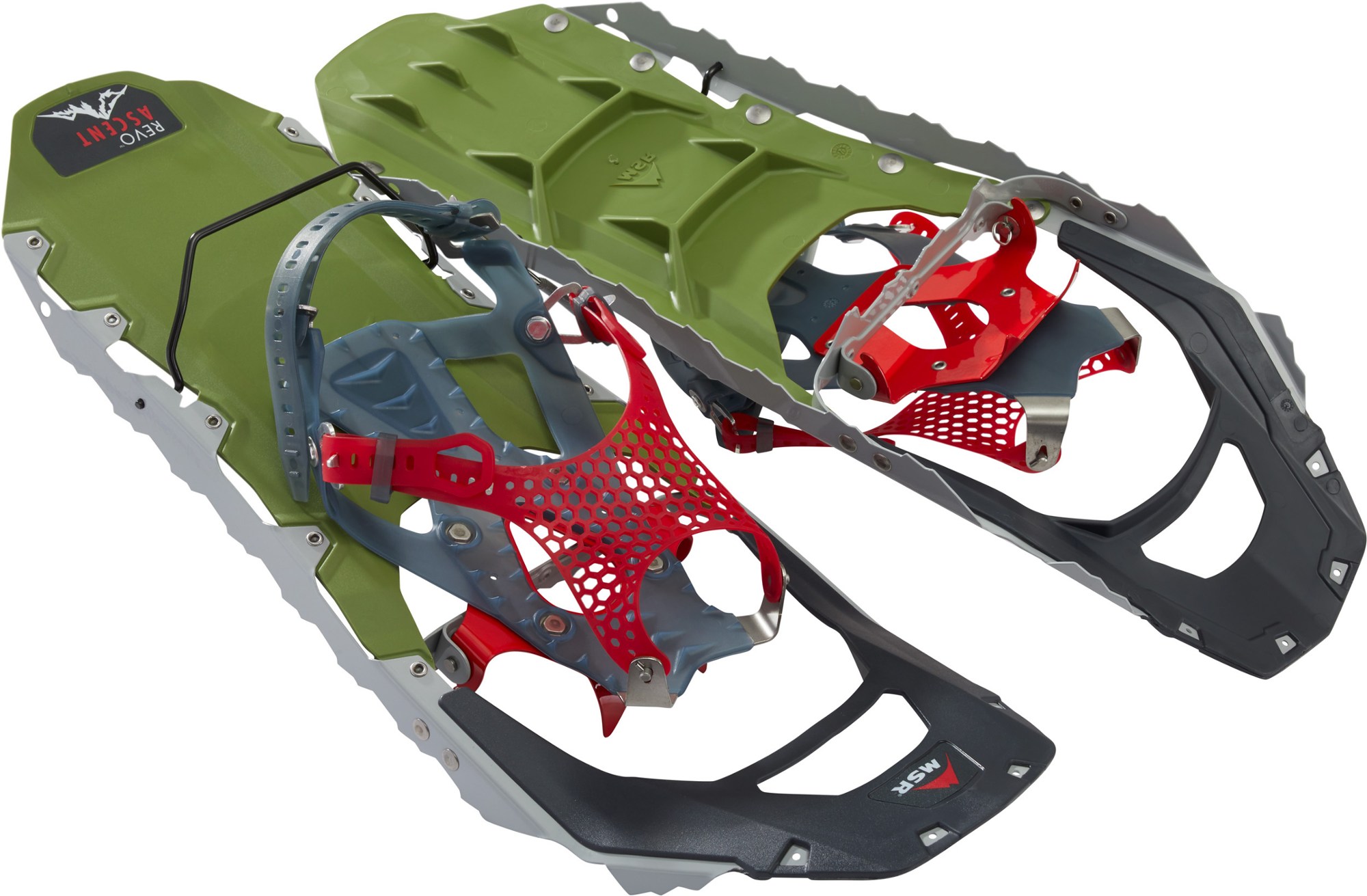
Weight: 4 lb, 2 oz
Length: 22” or 25”
Gender: Men’s and Women’s styles available
Gait: Narrow/women’s
Load: Up to 180 lbs, including gear
Frame: 7075-T6 Aluminum
Deck: Polypropylene
Best For: All snowshoeing conditions (flat to steep terrain)
When I unwrapped the Revo Ascents, I was a bit unsure that they would be able to stand up to the notoriously rough terrain we have here in New Hampshire. The composite material that makes up the frame doesn’t appear as rugged as some of the metal-framed snowshoes I’ve tested.
So, my chief worry going into the review centered around durability. MSR also advertises the MSR Revo Ascents as ideal for users with a narrow stride. As I have a narrow stride and also take shorter steps than most people, I wondered how these claims would play out in the field.
Check Price on REI Check Price on AmazonMSR Revo Ascent: Notable Features
It turns out that the MSR Revo Ascents performed great! These snowshoes never made me feel overwhelmed by their width or length. The Ascents aren’t MSR’s narrowest snowshoe (that award goes to the MSR Lightning Ascents), but the tapered design feels more ergonomic and less cumbersome than that model.
360-Degree Traction
The 360-degree bindings are another feature that streamlines navigating the twists and turns (especially on descents). I never felt overwhelmed by the size or width of these snowshoes, and that’s super important when you’re wearing them for hours at a time on narrow snowshoe trails.
360-degree traction means that no matter what portion of the snowshoe frame touches the ground, there will be traction touching the ground as well. This gives a much more all-around grip. It’s one of the most important features of snowshoes designed for hiking and climbing.
A con of the 360 traction is that the snowshoes have small teeth built into the frame. So if somehow the snowshoe frame rubs your skin or clothes, it could be more inclined to cut you or your clothes. Be careful where you attach your snowshoes to your pack to minimize this risk.
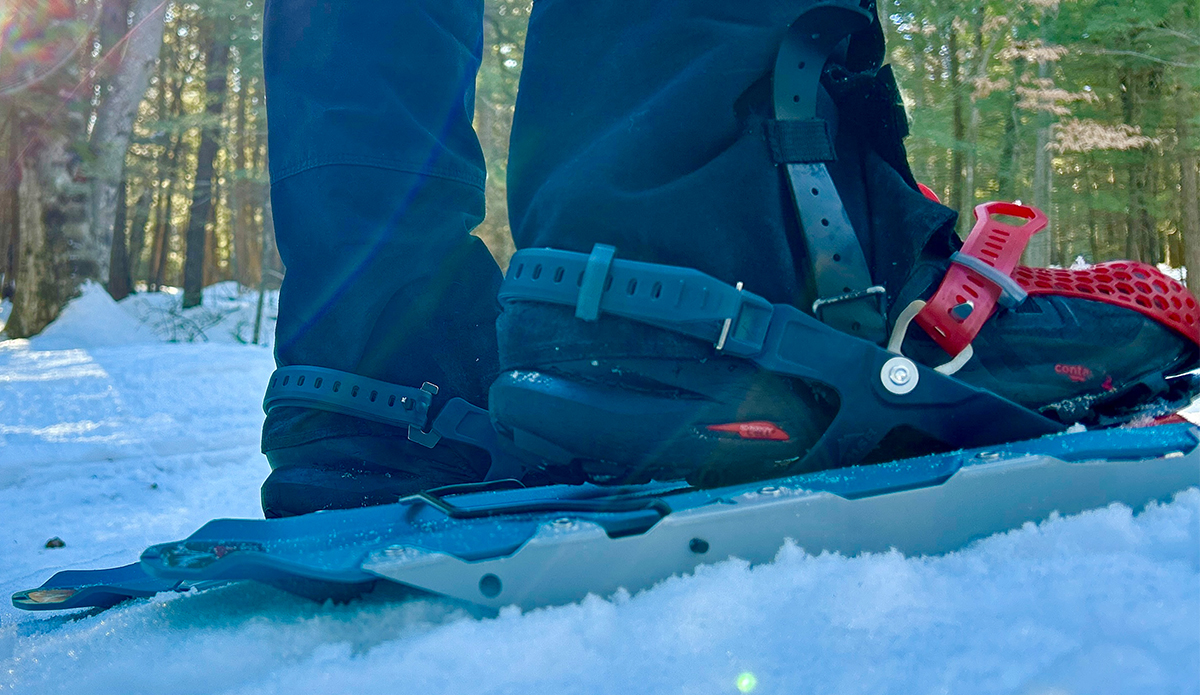
In this photo, you can see the heel lift bar just below the heel closest to the camera. Photo: Rebecca Sperry/The Inertia
MSR Revo Ascent’s Bindings
Comfortable and properly fitting bindings are super important when it comes to snowshoeing. The last thing you want is to get blisters or hot spots from poor-fitting snowshoes — trust me, I know. The MSR Revo Ascent’s bindings are the first I’ve encountered that don’t rub my heels raw.
Specifically, the two front straps on the Revo Ascent’s bindings are designed to keep your feet in place, without being compressed. In my experience, binding systems and straps are usually ratcheted down with some sort of lever or knob. These systems are easy to use but can cause circulation to be cut off from the toes. The Revo Ascents (as well as MSR’s other snowshoe models) uses straps to pull down the mesh binding onto the top of the foot, leaving circulation intact but feet securely encased in the binding.
Although they’re not quite as easy to use as the Boa bindings on some snowshoes, the bindings on MSR Revo Ascents are real winners.
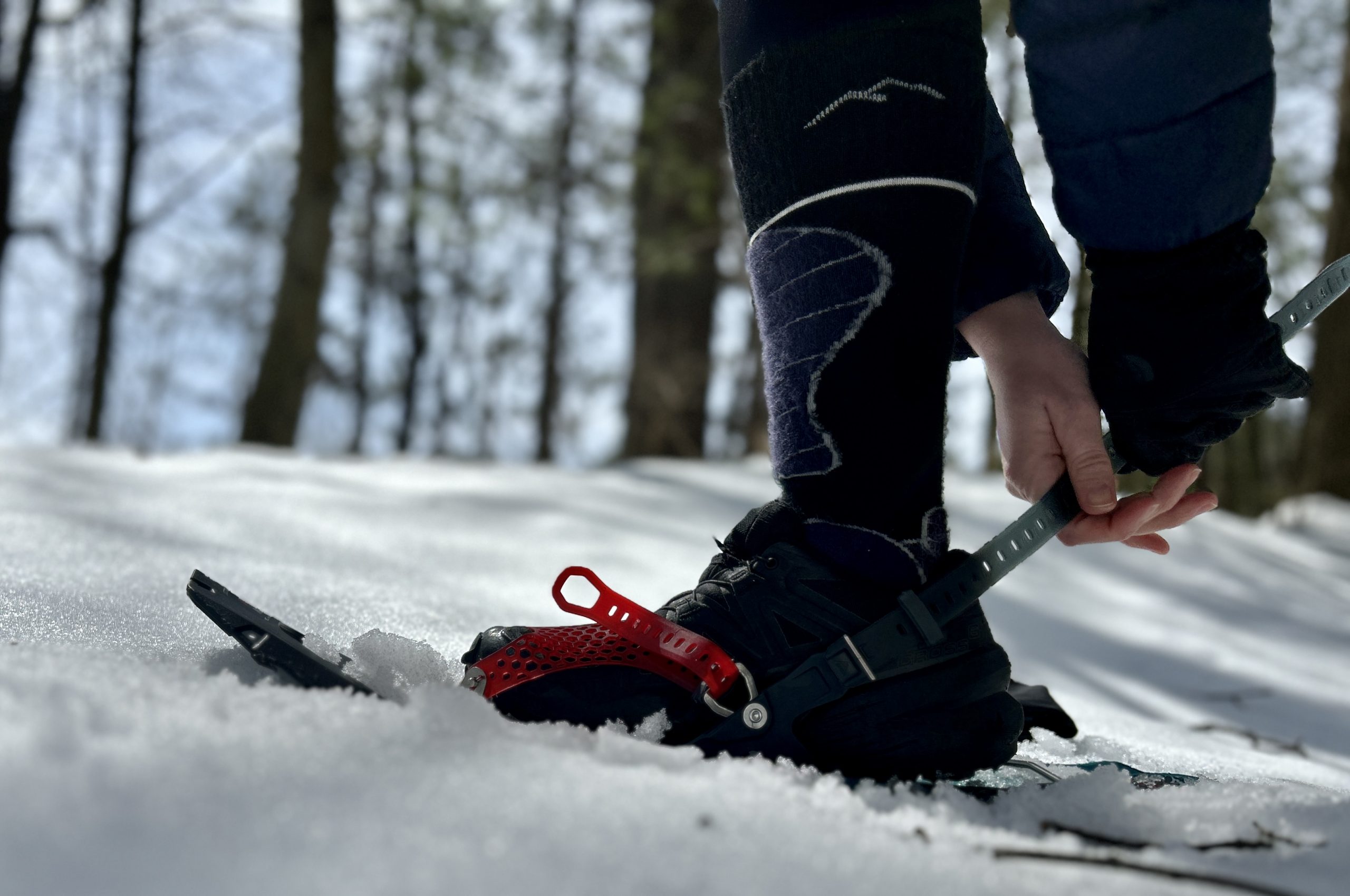
The MSR Revo Ascent’s strap-based binding system is comfortable and secure, if not quite as easy to use as a BOA system. Photo: Rebecca Sperry/The Inertia
Heel Lifts on the MSR Revo Ascent
Heel lifts are a game changer for snowshoeing uphill and a feature found on many MSR snowshoes. They alleviate added stress on your calves by allowing your heels to rest on a small bar that flips up from the back of the snowshoe frame. A con of heel lifts is that they are added weight (although we’re talking about ounces).
But for individuals looking to go as light as possible heel lifts are an added feature that can be eliminated to cut weight. Snowshoes that are designed to be ultralight come without heel lifts (for the most part). I found the heel lifts on the MSR Revo Ascents to be functional and easy to use.
Drawbacks of the MSR Revo Ascent
Perhaps the only drawback of these snowshoes is that they might be overkill for someone planning on hitting flat terrain. They are most definitely designed for more aggressive trail conditions, ascending mountains, and breaking trails, so if your only intention is to snowshoe on flat trails, look elsewhere. However, the price tag is reasonable for such an all-around functional snowshoe. So I’d recommend them if there’s even a chance you see ascents in your future.
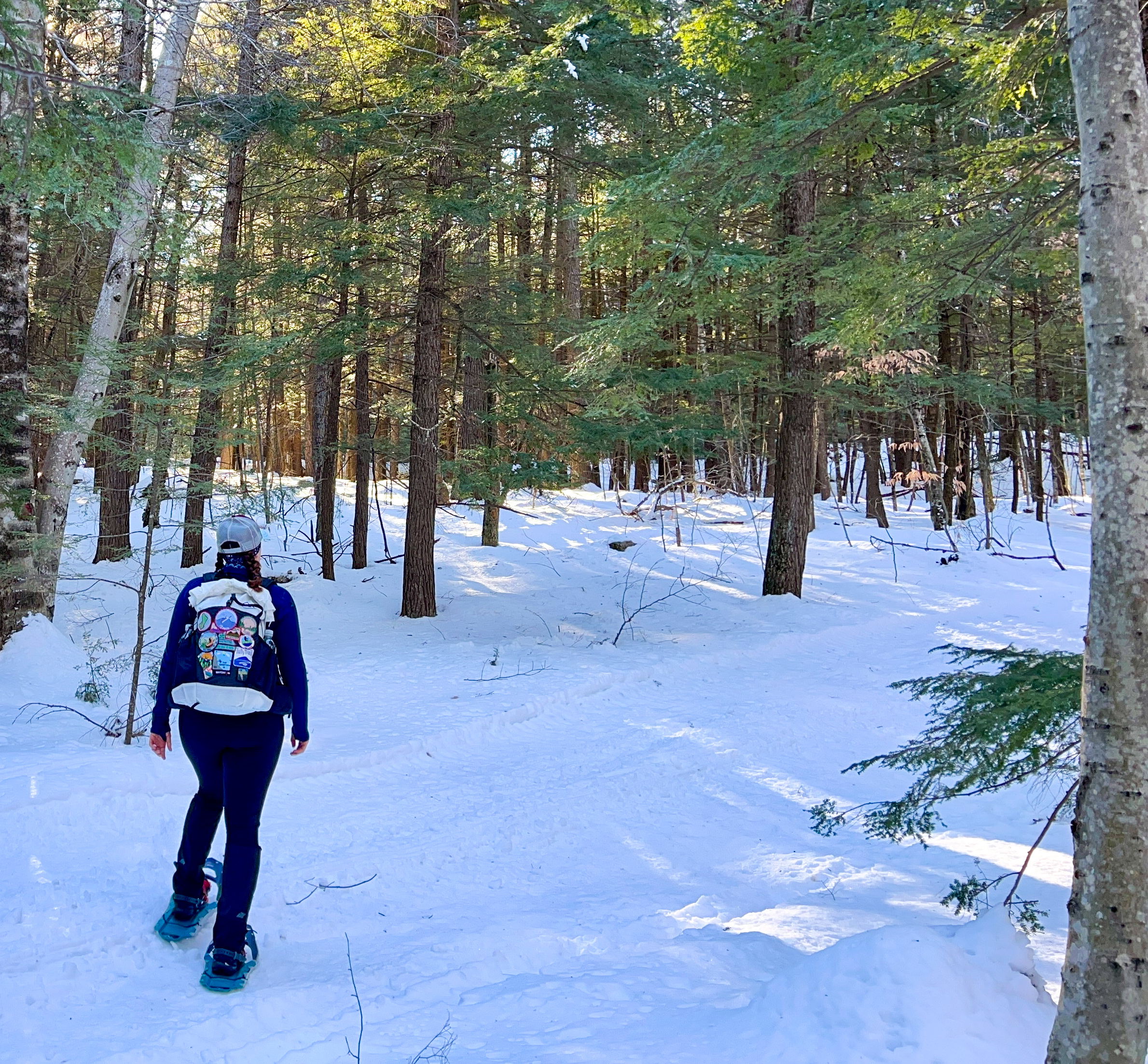
MSR Revo Ascents might be overkill on flat trails. But if you are looking for a quiver killer, this snowshoe is hard to beat. Photo: Rebecca Sperry/The Inertia
The Competition: MSR Lightning Ascents
The MSR Lightning Ascents are certainly competition for the MSR Revo Ascents. They have a slightly more aggressive set of traction and a more stable frame. The MSR Lightning Ascents are also one step up in terms of durability from the Revo Ascents.
Both the MSR Revos and MSR Lightning Ascents have the same binding system, heel lifts, and added traction. However, the MSR Lightning Ascent’s frame is not designed for a narrower gait. The MSR Lightning Ascents also come with a steeper price tag, which is why they did not earn the top spot for best overall snowshoes in our Best Snowshoes roundup.
MSR Revo Ascent: Final Thoughts
Overall, the MSR Revo Ascent snowshoes are a fantastic option for anyone looking to hit the trails this winter. They are designed to tackle all types of trail conditions, come with a very realistic price tag, and have the right added features to make trail-breaking less cumbersome. The narrower gait, fatigue-reducing heel lifts, and comfortable binding system that doesn’t restrict blood flow or cause blisters make them the ideal snowshoe for your winter adventures.
Check Price on REI Check Price on AmazonEditor’s Note: If you’re planning a long day in the mountains, make sure to bring food and something to cook it with. Don’t miss our guides for the Best Backpacking Meals and Best Backpacking Stoves. For more gear reviews and features on The Inertia, click here.



